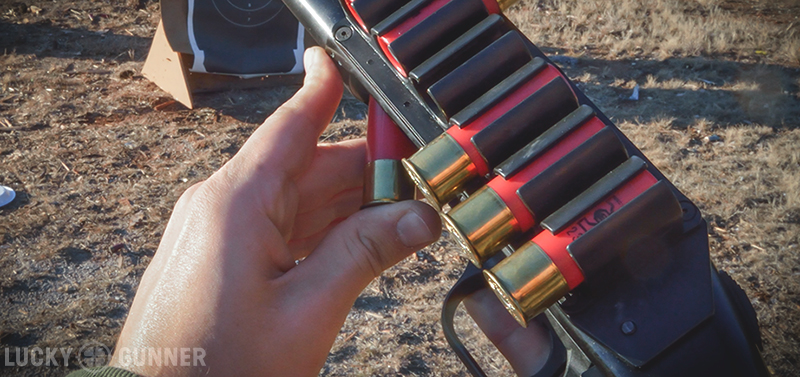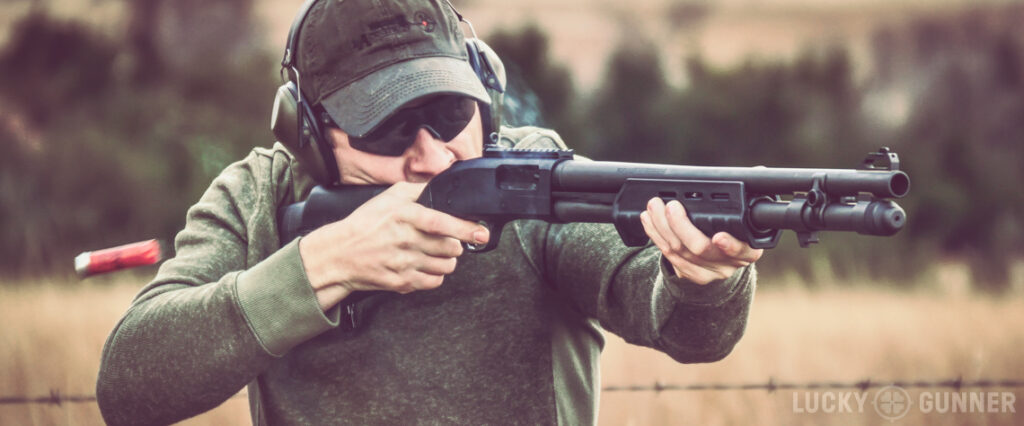If you’ve ever considered getting a pump-action shotgun, then you’ve likely taken a good hard look at both the Mossberg 500 and the Remington 870. When it comes to these companies and their shotguns, it’s almost like choosing between getting a Mac or a PC; there are die hard fans of each and, once you find what you like, you’ll usually stick with it. Me? I’m a Mossberg man, and I’ve had a Mossberg pump-action of some kind or another for the last decade.
My first shotgun was a Mossberg Maverick 88, and my first straight 25’s in both skeet and trap were with Mossberg pumps; a 590 Mariner and 500 field model respectively. I certainly respect the Remington 870 and those that prefer them, but the Mossberg has never given me a reason to want anything else. That said, the Mossberg series of shotguns have some design peculiarities that are worth investigating in order to decide if it is the right choice for your home defense shotgun.
The Basics
Every Mossberg 500 and 590 shotgun starts out with an aluminum receiver. Because of this, Mossberg guns manage to remain lightweight while still being strong enough to handle rough duty. Mossberg shotguns are no strangers to being stuffed in a police cruiser or dragged through a swamp, and in recent years, they have proven themselves as very capable breaching tools and combat weapons in Iraq and Afghanistan. Their reputation is pretty compelling, but it’s hardly the only reason to choose a Mossberg for your home defense gun.

In addition to its lightweight construction, the Mossberg 500 series has a couple of nice features that make it exceptionally intuitive to use. The first is its shell lifter. Unlike almost every other repeating shotgun on the market, the Mossberg’s shell lifter only lowers for an instant during the loading cycle when the slide is all the way to the rear. This prevents debris from being able to accumulate inside the receiver and also helps make loading easier. With the gun upside down shells can be dropped into the receiver and simply pushed into the magazine tube which is helpful should you lose your grasp on a round under stress. Additionally, there is no risk of having your thumb or glove caught between the shell lifter and magazine since it rests up and out of the way.
Most Mossberg defense shotguns also incorporate a fully ambidextrous safety located on the tang of the receiver. This safety is easily accessed by the firing hand thumb from either side of the gun. The slide release on all models is located just behind the trigger guard on the left side of the gun and can be easily manipulated with the firing hand as well. All of these features come together to help make the Mossberg 500 and 590 shotguns some of the most ergonomic and user-friendly pump actions on the market, and this success has led to a truly massive product catalog.
Models
Mossberg has over one hundred distinct pump-action shotgun models. For the purpose of this overview, we’re going to focus only on the ones most suitable for defensive use. The shotguns that fall into this category are the Maverick 88 Security, the Model 500 Tactical, and the Model 590/590A1. Each gun operates the exact same way, but there are slight variations between them that will impact their usefulness depending on your needs. So, here is a quick breakdown of what each model brings to the table.
Maverick 88 Security
The Maverick 88 line is Mossberg’s budget brand and seeks to deliver the basic function and reliability of the Model 500 at a reduced retail price. Maverick 88 security guns are only offered in 12 gauge and have a capacity of either six or eight shots. The Maverick 88 cuts down on costs by using a simplified one-piece fore-end, which does not allow it to be changed out with an aftermarket one unless you purchase a model 500 slide tube assembly also.
The Maverick 88’s receiver is not drilled and tapped for a scope mount and the finish tends to look slightly purple depending on the lighting. The polymer trigger group includes a push-button safety and is not ambidextrous like the tang-mounted safety Mossberg is known for. Older Maverick 88’s may also only have a single action bar rather than the two on 500 and 590 models, but function should still be fine.
Mossberg 500 Tactical
The Mossberg 500 Tactical is Mossberg’s mid-grade defensive shotgun line and is available in 12 gauge, 20 gauge and .410 caliber. Like the Maverick 88, the Mossberg 500 is available as either a six or an eight-shot model. The model 500 has an ambidextrous tang-mounted safety, and its receiver is drilled and tapped for a scope mount.
The metal finish on the receiver is superior to that of the Maverick 88 and the fore end can be disassembled to allow switching to an aftermarket fore-grip if desired. The trigger group and safety button are polymer and are not compatible with the Maverick 88. These guns also feature front and back sling attachment studs as a small bonus over the Maverick 88 and help to justify the higher price point.
Mossberg 590/590A1
The Mossberg 590 and 590A1 are Mossberg’s premium defense guns. They utilize a different magazine tube that allows an extra shell to be loaded for a total of 9 shots on 20” barrel variants, and, like the model 500 and Maverick 88, there is a 6 shot 18.5” barrel version as well. This capacity advantage helps the 590 stand out among other defensive shotgun offerings available. Additionally, most 590 and all 590A1 models feature a bayonet lug, which is neat but definitely not a necessity.
The 590A1 series improves even further on the basic 590 by incorporating a much heavier barrel, a tough parkerized finish, and a metal safety button and trigger assembly. These features will prevent the gun from potentially being damaged by rough use, and it will also give the gun a good deal more heft, which can be good or bad depending on who will be using it.
Where to Start
If you’re not looking to invest heavily in an ultra-capable defensive shotgun, then the Maverick 88 Security models will work fine. The 8-shot model is a particularly nice gun for the price. However, if you’re looking for a starting point to begin building your ultimate HD shotgun, it’s probably best to start with a Model 500 Tactical in the six-shot configuration. This option is sometimes marketed as the “Persuader” and is the most versatile defensive shotgun Mossberg makes. It’s ready to serve bedside duty right out of the box, but it’s also ready to accept any number of aftermarket parts to tailor it to your individual needs.
The six-shot models have the particular benefit of being compatible with a wide range of barrels, including field and slug barrels, that the higher capacity gun cannot. The popularity of these guns also means that there’s a healthy number of them available on the used market.
The 590A1 models can save you some time by including a host of premium parts right from the factory, and for a defensive pump, it’s hard to find anything better. The only issue with going this route is that, if you’re still learning the ins and outs of the defensive shotgun, then you may end up ditching or replacing parts you’ve already paid good money for.
When you do get your hands on a starter gun you’ll find that aftermarket accessories are plentiful, and much of what Chris had to say in his article about customizing a Remington 870 is very applicable to the Mossberg platform, with the notable exception of magazine extensions.
What to watch out for
Mossberg quality is pretty even across product lines so reliability and solid function should not be an issue with any gun covered here, and in the event something does break, spare parts are not in short supply. If you’re buying used, you may find that the Mossberg’s action feels loose, but this is typical of a well-worked Mossberg. So long as the action remains locked when the slide is fully forward then there shouldn’t be any problems. Also, be prepared for the Mossberg’s fore-end to feel a bit wobbly compared to a Remington 870 or Benelli Nova. It is a bit disconcerting if you aren’t terribly familiar with pump actions, but it does not hinder function.
Another thing to be cautious of is the FLEX system used by some model 500s and 590s. The FLEX system is fancy and does allow for quick stock and fore-end changes, but you are then limited to Mossberg’s compatible accessories which are lacking when it comes to some of the very good aftermarket stock and fore-end options. Since you’ll also likely pay a premium for the FLEX system guns in addition to being limited in your configuration choices, I would give them a pass.
While the Mossberg may not have quite the following of the Remington 870, it truly does stand on its own in the market and is a very good option to explore when choosing a defensive shotgun. With broad aftermarket support and some very user-friendly controls, the Mossberg is likely to remain one of the pump shotgun kings for many decades to come.



